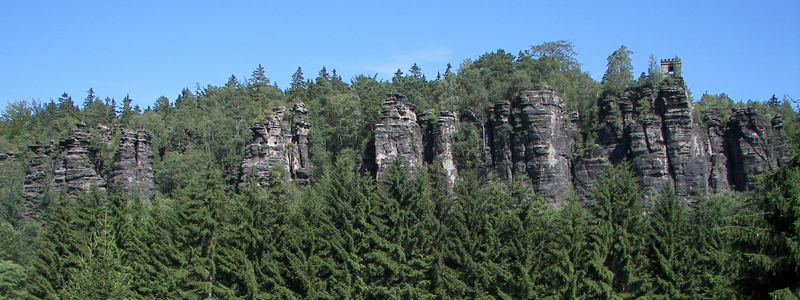Rosenthal-Bielatal
Rosenthal Bielatal is a municipality with 1704 inhabitants in the district of Saxon Switzerland & Eastern Ore Mountains on the border with the Czech Republic. It belongs to the administrative community Königstein / Saxon. Schw.
- 5.1 traffic
- 5.2 Education
Geography
Geographical Location
The municipality is located in the Rosenthal -Bielatal linkselbischen Saxon Switzerland, more precisely in the Biela valley, which extends from the Czech Ostrov up to Königstein. East of the church rises the Lampert stone. The highest point of the municipality lies at 533 m in the Glaser foundation, near the Czech border. The place is surrounded by a large forest area. The deepest point is located at the mouth of Cunnersdorfer Bach in the Biela at 160 m.
Community structure and incorporations
The current community Rosenthal Bielatal formed by the gradual association of nine villages and iron hammers and hammer goods.
Biela valley was created in 1933 by the merger of the village Hermsdorf the settlements Reichstein and stone shower, both of which emerged from two hammer mills. The small settlement area was incorporated on July 1, 1948 after the Biela valley.
Rosenthal created by the merger of the village of the same with the former iron hammers envy, Upper huts, petrol mill and the sanatorium Schweizermühle.
The union of the Biela valley and Rosenthal on January 1, 1994.
Neighboring communities
To the church Rosenthal Biela valley in the east borders the municipality Gohrisch, in the north of the town of Königstein and in the west the town of Bad Gottleuba- Berggießhübel.
Partner communities
- Betzenweiler -Walde, Baden- Württemberg
- Eitelborn, Rhineland -Palatinate
- Jílové, Czech Republic
History
Rosenthal was first mentioned in 1356. Until 1503 it belonged to Bohemia, then to Saxony. The Hermsdorf has been known since 1410, while the settlement Reichstein from a 1492 first -mentioned iron hammer east of Biela ( "hammer to Reichensteyn on the Bile bey Pirne " ) was born. The hammer produced until 1733 scythes and plowshares " Gezeug ". An upheaval experienced the community in the early 19th century through the establishment of water-cure establishment Swiss mill, which was also frequented by members of the European aristocracy. 1879 Volunteer Fire Department was founded in Rosenthal. 1912 Cold Water Agency was closed and used by the Maggi company as a convalescent home for their employees. In GDR times, the buildings were used as a sanatorium for tuberculosis sufferers and as a retirement home. In the Biela valley there is since 1958 a carnival club. Since 1992, coming in January each year about 20 children from Chernobyl to recover in Rosenthal.
Culture and sights
- Climbing area Biela valley: In the Biela valley is found with 239 peaks over 3,400 and climbing for all levels of the most diverse and most popular climbing areas in the Saxon Switzerland.
- Blast furnace Brausenstein, as a witness of the iron and steel industry in the Biela valley and cultural monument
- Pillars of Hercules, Leaning Tower, Pulpit Tower, Daxenturm, grandfather's chair, Spannagelhaus Tower, Abandoned wall, barrier plate, Abandoned foresters, forest needle, Biela pinnacle, eagle rock, forest guards, Glaziers basic tower, meadow stones, locust watch, Saxony stone and other rocks in the Biela valley.
- Ice Cave, Sweden cave and Benno cave above the petrol mill.
- Panorama height ( 426 m above sea level. NN ) in the northwest of Hermsdorf, with a distant view to the stone lilies, Pfaffenstein, Gohrisch, Papststein, Great Zschirnstein, Cottaer Spitzberg, high snow mountain and to the fortress Königstein.
Policy
In 2012, the council shall submit a contract for incorporation before in the town of Königstein. The 2013 referendum majority chose it.
Economy and infrastructure
Traffic
At the beginning of the 20th century, the upper Biela valley should have a connection through the Biela Valley Railway opened in 1901, received the planned extension to Schweizermühle was not for financial reasons to pass. In September 1904, the line was closed again.
In public transport Rosenthal Bielatal is provided by bus 242 ( Königstein - Rosenthal) uses the Oberelbischen transport company Pirna- Sebnitz ( OVPs ), 245 ( Pirna - Rosenthal) and 247 ( Rosenthal Berggießhübel - - Bad Gottleuba ). The line 247 is merely for the school transport, while the line 242 and 245 also go on weekends and are mainly used by day trippers. On the lines 242 and 245 must be accompanied by a trailer transporting bicycles in the summer on weekends, as well as both lines are led with some rides on the disabled for the rest of motorized traffic road to the Czech border north of the Great Snow Mountain.
Until 1938, led the main link between Pirna and Decin, today's federal highway 172, about Hermsdorf and Rosenthal. After completion of the continuous road link in the Elbe Valley on Schmilka the route via Rosenthal lost its importance. Released the road is only for walkers and cyclists as well until just before the limit for buses OVPs.
Education
By 1990 there were in Rosenthal and Bielatal each school. With the construction of a new high school in 1990 in Rosenthal, the two schools were closed. The high school was founded in 2004 converted into a primary school, which taught per grade level 1 class. The primary school has about 80 students and 6 teachers.
Personalities
- Gottfried August Homilius (1714-1785), composer, pianist, organist and choirmaster
- Kersten Lahl ( born July 6, 1948), Lieutenant General retired of the army of the German Armed Forces, President of the Federal College for Security Studies in Berlin
- Karl Gottlob Clausnitzer (1714-1788), Lutheran theologian










